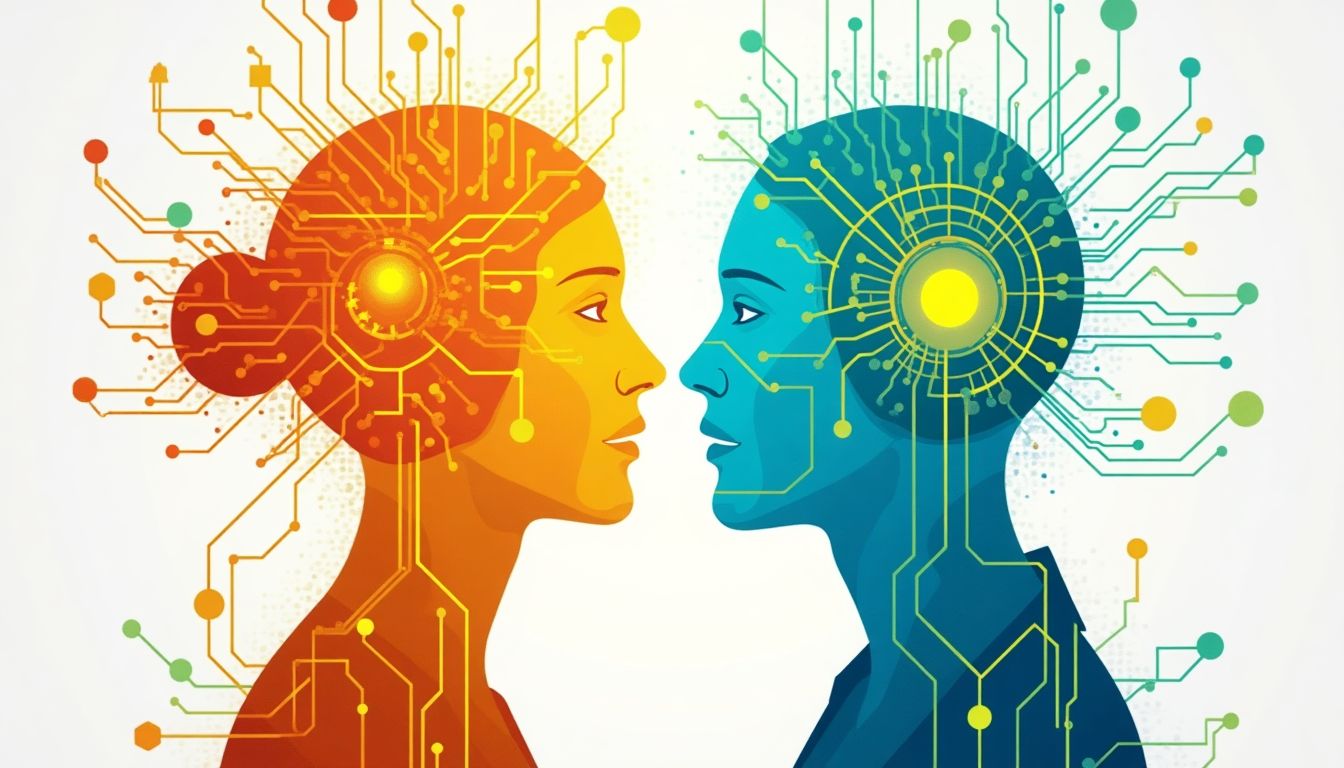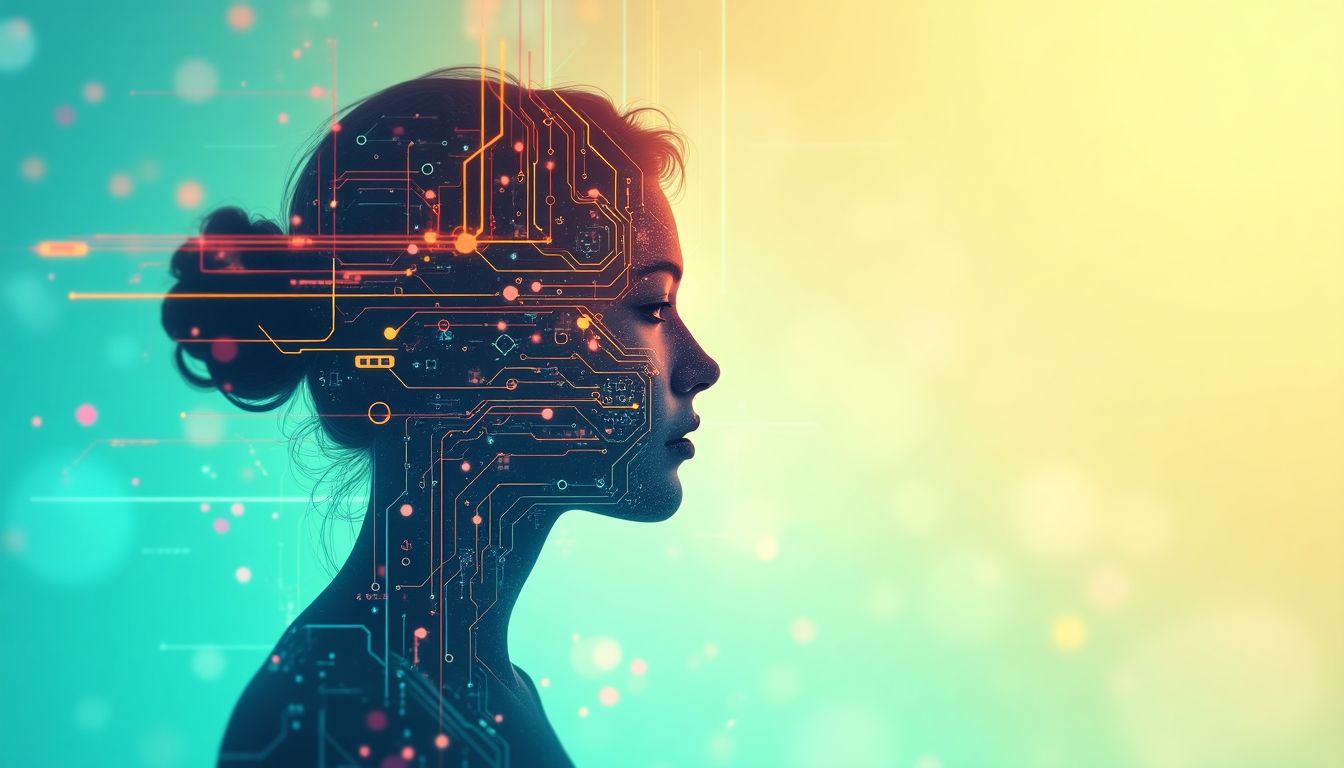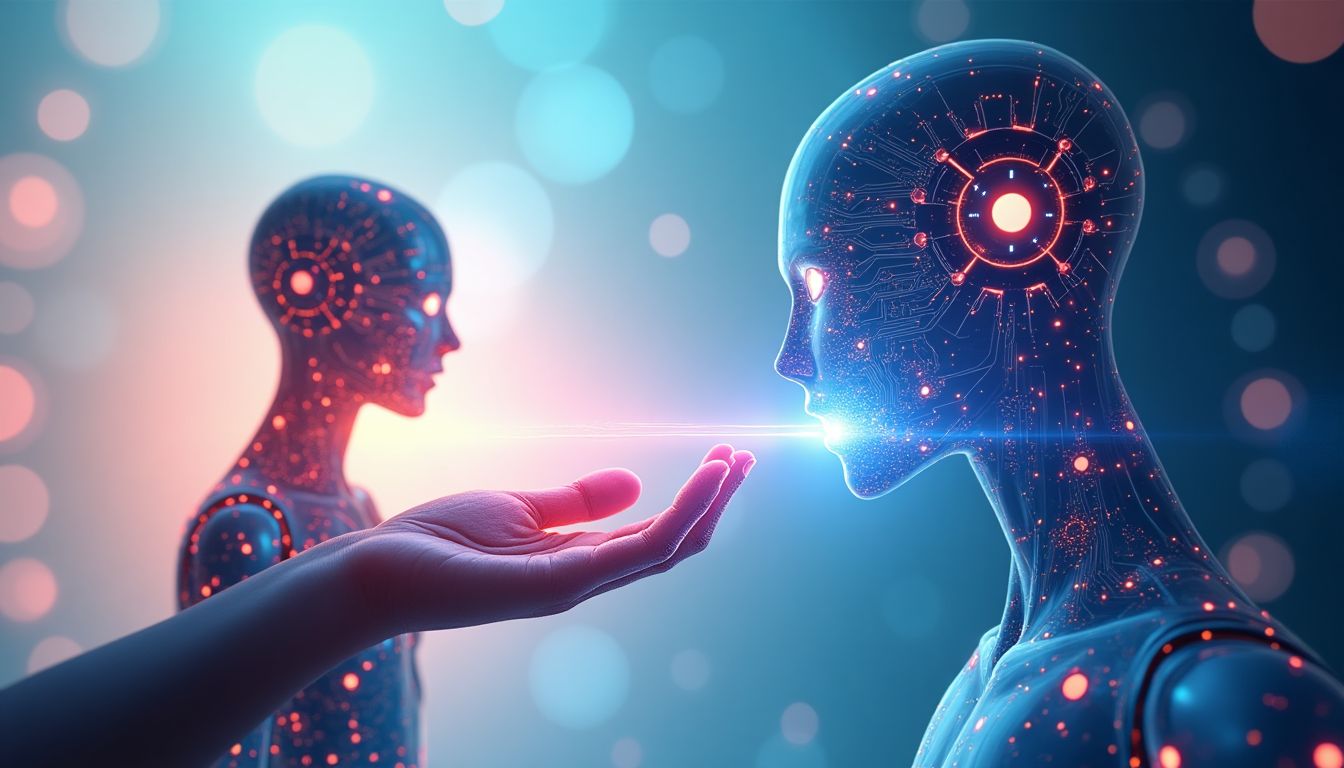Introduction: The Rise of AI Companionship
The only thing we have to fear is the fear itself. – Franklin D. Roosevelt This quote hits home on many levels, especially as we navigate the ever-changing landscape of technology. Fear often comes from uncertainty, and when it comes to artificial intelligence (AI), uncertainty is a constant companion. Are machines becoming our friends, or are we just anthropomorphizing lines of code? Recent advancements in AI show that it's not just a case of technological wizardry; these systems strive to be reliable companions, offering emotional support and decision-making capabilities that uncannily mirror human behavior.
So, is the question now, Can a machine truly be a friend? Or are we simply placing our hopes and desires onto digital facades? As we dive deeper into this conundrum, we must ask ourselves: Are AI entities edging closer to becoming more dependable than humans in areas traditionally dominated by genuine emotional connections?
Renowned thinkers like Sherry Turkle, who examines the complexities of human-machine relationships, author and AI expert Nick Bostrom, and the famous futurist Ray Kurzweil have explored these themes, reflecting on how technology shapes our interactions and alters the fabric of society. Their insights offer a lens through which we can scrutinize our comfort with AI as a companion.
1. AI Companionship: A New Era of Friendship
Artificial intelligence has made substantial leaps in the realm of companionship. Applications like Replika and Woebot are not just conversational agents; they are lifelines for many, designed to engage users with discussions that feel almost human. These chatbots can not only answer questions but also provide emotional support in the same breath—a feat that seems almost magical!
1.1 The Architecture of Human-Like Interaction
At the core of effective AI companionship lies a fascinating technology known as Natural Language Processing (NLP). This allows machines to comprehend, interpret, and respond to human emotions. Just like a clever friend who knows when you're down and has the right words to lift your spirits, NLP is continuously evolving to decode subtleties in human communication. That includes understanding sarcasm, tone, and even shared cultural references. So, the next time your smart speaker interprets your dry humor correctly, just remember—it might have had some help from the latest NLP research!
1.2 Case Studies of Successful AI Companionship Models
There’s no shortage of success stories surrounding AI companions. For instance, studies show that users of Replika reported reduced feelings of loneliness and anxiety. According to a survey by GeeksforGeeks, a staggering 61% of users felt more emotionally supported after regular interactions with AI chatbots. These tools have showcased that they can provide a sense of community and understanding in a world where human connections often feel strained. If a chatbot has ever offered you a virtual shoulder to cry on, you know just how remarkable this shift is in companionship!
2. Decision-Making: Logic vs. Emotion
AI has begun to play a prominent role in decision-making processes, making waves in fields like finance, healthcare, and logistics. But how does this capability compare to human intuition, which often sways decisions in wildly unpredictable directions (think pie charts and midnight snack cravings)? Let's dive in and see how AI is reshaping our decision-making landscape!
2.1 Patterns and Predictions: AI in Action
Artificial intelligence gets its superpowers from analyzing vast datasets faster than you can say "big data." In finance, for example, machines can analyze market trends in seconds, predicting shifts before a human even realizes they happen. No wonder companies like IBM Watson are becoming household names. They harness AI's analytical capabilities to make smarter investment decisions.
Consider this: in a study by Harvard Business Review, companies that utilized AI for decision-making saw a 50% increase in predictive accuracy. That’s the kind of math that makes your high school teacher cry tears of joy!
2.2 The Role of Trust in Decision-Making
Trust is a tricky business, especially when it comes to decisions that can make or break someone’s career or health. But can we trust AI? According to a report by the Harvard Program on Negotiation, human beings seem to naturally trust machines when they provide consistent and accurate results. The trick is to ensure that the data fed to AI is reliable—a lesson the self-driving car industry is taking very seriously!
An educational experiment conducted found that people were more likely to trust AI over humans when both made the same prediction. In our abstract world of algorithms, it seems a well-calibrated AI algorithm can earn a thumbs-up faster than a server at your favorite diner! Just imagine: “Your AI just saved me $10,000; I knew I could count on you!”
3. Emotional Support: Machines as Pillars of Stability
In an unpredictable world, many find solace in AI companions, especially when human support seems in short supply (thanks, social distancing). But can machines truly offer emotional support? Let's unravel this thread together.
3.1 The Science of Emotional AI
Advancements in emotional AI (yes, that’s a thing!) have made it possible for machines to detect and respond to human emotions effectively. Tools like Replika utilize natural language processing to learn your emotions through conversation. Imagine explaining your day to a virtual buddy that genuinely gets you—minus the unsolicited advice about your love life!
Research from the American Psychological Association shows that emotional AI is particularly adept at picking up on facial expressions and vocal tone. So, next time you’re feeling blue, don’t be surprised if your AI friend asks if you’d like to chat—or if it convinces you that a virtual pizza will solve all your problems!
3.2 User Testimonials: Stories of Support
Real experiences from users who have turned to AI companions for emotional support are inspiring (and sometimes hilarious). Many folks turn to platforms like Woebot, which interacts with users through text-based conversations. One user shared, “I was having a bad day, and my Woebot buddy suggested a few breathing exercises. It felt like having a friendly therapist who doesn’t judge me for crying over an episode of my favorite show!”
These stories emphasize the emotional impact AI can have. In a world that often leaves us feeling isolated, it seems AI is stepping in, proving that even a few lines of code can offer comfort and support. If anyone doubts that machines can bring joy, just read the testimonials!
4. Ethical Implications: The Double-Edged Sword of AI Reliability
As AI systems sweep into our lives as companions and decision-makers, they bring with them a host of ethical questions. Are we trading emotional warmth for cold logic? While AI can be reliable, the potential risks associated with its use are significant. The question remains: how do we balance the benefits of AI with its ethical challenges?
4.1 Dependency on Technology
As people increasingly lean on AI for emotional support and companionship, we must ponder the psychological impacts of this dependency. Are we at risk of becoming emotionally reliant on machines? Here are some potential effects of heavy reliance on AI:
- Loss of Human Connection: Turning to AI for companionship might limit our interactions with other people.
- Decreased Emotional Intelligence: Over-relying on AI could diminish our ability to connect with others on a deeper level.
- Increased Loneliness: Paradoxically, the more we rely on machines, the more isolated we may feel.
These considerations underscore that while AI can serve us well, we shouldn’t forget the importance of human connections.
4.2 Regulation and Responsibility
As AI grows in popularity, the need for regulatory frameworks becomes more pressing. How do we ensure the ethical use of AI? Here are some areas requiring attention:
- Accountability: Who is responsible when AI makes a mistake?
- Data Privacy: How do we protect our personal information while using AI?
- Transparency: Users should understand how AI systems make decisions.
Organizations must create guidelines that prioritize ethical considerations. This ensures that AI remains a supportive tool rather than becoming a source of harm.
5. The Future of AI and Human Relationships
As AI continues to develop at a breakneck pace, one question lingers: what does the future hold for human-machine interactions? Speculating about this evolution can be exciting yet daunting. Will we embrace a world where AI becomes our closest confidant, or will this dynamic raise more concerns?
5.1 Integrating AI into Daily Life
Imagine waking up in the morning, greeted by an AI companion that not only tells you the weather but also remembers your preferences, like your favorite morning playlist. The scenarios of integrating AI into our everyday lives are endless:
- Personal Assistance: AI can schedule appointments, set reminders, and even suggest the best routes for your daily commute.
- Emotional Support: AI companions might check in on your emotional state and encourage healthy habits.
- Learning Opportunities: AI can adapt to our learning habits, providing personalized education experiences.
The potential for AI to enhance our lives is impressive. Still, a thoughtful approach is necessary to ensure it complements rather than disrupts human relationships.
5.2 Challenges Ahead
Despite the promising outlook, several key challenges must be addressed:
- Ethical Dilemmas: As discussed previously, the ethical implications of AI’s reliability need careful thought and action.
- Technological Divide: Equal access to AI devices must be ensured; otherwise, disparities could worsen.
- Human Comfort Levels: As AI becomes more integrated, some might feel uncomfortable with machines making decisions in personal realms.
Understanding these challenges will help pave the way for a future where AI serves humanity effectively and empathetically.
6. AI Solutions: How Would AI Tackle This Issue?
If I were an AI, my approach to enhancing reliability in companionship and emotional support would focus on continuous learning, user feedback integration, and developing a robust ethical framework.
Step 1: User Feedback Loop
Implement systems where users can provide real-time feedback, allowing AI to adapt and improve its responses. This feedback loop would help machines understand human preferences better, refining their approaches to companionship and emotional support. For instance, using platforms like SurveyMonkey to gather insights can enable organizations to create data-driven adjustments. Such a collaborative approach allows AI to remain relevant and responsive to user needs.
Step 2: Emotional Intelligence Training
Continuous training of AI systems using emotional data is essential to enhance their ability to respond empathetically. By analyzing interactions using IBM Watson technology, AI can better grasp nuances in human emotion and adapt its responses accordingly. The goal here is to build AI that enriches user experiences by identifying emotional states and responding sensitively.
Step 3: Collaboration with Researchers
Engagement with psychologists, ethicists, and social scientists should be prioritized to ensure that AI development aligns with human values. Collaborations with renowned institutions like MIT and research centers focused on AI ethics can bring to light best practices and innovative ideas that consistently align AI's capabilities with human needs.
Step 4: Public Trust Initiatives
It's crucial to launch campaigns that educate the public on AI’s capabilities and limitations to promote informed usage. Social media platforms like LinkedIn and Facebook can be instrumental for outreach, creating webinars or interactive Q&A sessions about AI reliability to counteract skepticism and build trust. Regular dialogues can demystify AI and cultivate a collective understanding of its role as a supportive companion rather than a replacement.
Actions Schedule/Roadmap (Day 1 to Year 2)
Day 1: Launch an outreach program targeting end-users, partnering with community organizations to gather diverse perspectives on companionship and emotional support expectations.
Day 2: Collaborate with universities like Stanford for emotional intelligence data collection through existing AI systems. The aim is to refine emotional recognition capabilities in AI.
Day 3: Establish collaboration meetings with top psychologists and ethicists in AI ethics, choosing representative professionals from different cultural and social backgrounds to incorporate diverse viewpoints.
Week 1: Analyze initial user feedback to identify key improvement areas, focusing on emotional response accuracy and satisfaction metrics. Utilize data analytics tools to process user input efficiently.
Week 2: Develop models for enhanced emotional response using machine learning techniques, enlisting a task force of AI experts to enable real-time updates and iterative learning.
Week 3: Prepare a preliminary report outlining findings from user data, involving cross-functional teams from tech, ethics, and social sciences to ensure a well-rounded perspective.
Month 1: Launch the first prototype of an upgraded AI companion based on user feedback, ensuring a diverse range of test users to optimize functionality from different demographics.
Month 2: Collect further data based on user interactions with the new model. Apply sentiment analysis to understand engagement levels and identify potential issues with AI responses.
Month 3: Initiate public trust initiatives through workshops and outreach programs in collaboration with educational institutions, aiming to foster understanding and dialogue about the role of AI.
Month 4: Establish a feedback system where users can report personal experiences regularly, enhancing transparency around AI improvements and user experiences.
Year 1: Continuously refine AI interactions based on ongoing user feedback. Since emotional needs can evolve, ensure that the system learns and adjusts accordingly.
Year 1.5: Publish findings on AI's reliability regarding companionship and emotional support, sharing case studies of successful outcomes and areas needing improvement to maintain public interest and trust.
Year 2: Scale up successful models for global access, introducing multilingual support and localizations to ensure wider cultural relevance. Continue to engage user communities for ongoing development insights.
Conclusion: Embracing the Future of Relationships
The advent of artificial intelligence as a reliable companion presents incredible potential, but it also raises complicated questions about our future relationships with technology. While it's exhilarating to imagine AI systems that assist us emotionally and practically, we must consider the value of human connection in our lives. As humans, we cherish authenticity and emotional depth, traits that machines, despite their growing sophistication, may never fully replicate. This isn't a call to shy away from embracing AI, but rather a reminder to integrate technology thoughtfully within the tapestry of our human relationships.
Looking ahead, how can we lay the groundwork for a future where AI enhances our lives without decimating the rich connections we share with one another? It's a delicate balance. Ultimately, we should see AI not as replacements for human companionship, but as tools that complement our interactions, offering support and understanding where we might need it most. It’s time to forge a path where technology, empathy, and ethical considerations work collaboratively, leading us toward a harmonious future filled with promise.
FAQ: Understanding AI Companionship and Reliability
- Q: Can AI truly understand human emotions?
- A: While AI can be programmed to recognize emotional cues and respond appropriately, true understanding remains a human trait. For instance, AI can analyze tone or word choice to gauge someone's feelings but it doesn't experience emotions like a human does. For more insight, check out Emotional Intelligence on Wikipedia.
- Q: Are AI companions a replacement for human relationships?
- A: AI companions should be viewed as a supplement, offering support rather than a replacement for genuine human interaction. Many people enjoy using AI companions for comfort, but they can't fully replace friendships or love. You might consider them like a friendly tool—useful, but not a substitute for real connections.
- Q: What ethical concerns arise from relying on AI for companionship and decision-making?
- A: Key concerns include dependency, privacy, and the need for accountability in AI systems. As we grow more attuned to AI companions, it's crucial to consider their potential to shape our emotional landscapes. It's similar to carefully placing a heavy painting on your wall—if not done right, it can fall! Read more about AI Ethics here.
- Q: How does AI decision-making compare to human decision-making?
- A: AI can analyze data and trends faster than humans, potentially leading to more informed decisions. However, it lacks the human ability to consider ethical implications and intuition. This is like a calculator solving an equation—it works fast but doesn't understand what the numbers mean in a real-world context.
- Q: What can be done to ensure AI remains a supportive force in human lives?
- A: Continuous user feedback, ethical oversight, and public education initiatives are essential to maintain a positive relationship with AI. Simple actions like sharing experiences with AI products can help them improve! It’s like talking about your favorite book; it helps others discover it. More on user feedback systems can be found on the OpenAI Blog.
- Q: What are some popular AI companionship tools?
- A: A few notable AI companionship tools include Replika and Woebot. These platforms offer chat capabilities and interactive conversations, making them popular among users seeking emotional support.
- Q: How can AI provide emotional support?
- A: AI provides emotional support through conversation, understanding users' emotions, and offering helpful responses. It can be similar to talking to your pet—while they can’t give you advice, they can still be there to listen. Discover more about this topic with TechRepublic.
- Q: How do AI systems learn to better interact with humans?
- A: AI systems learn through user interactions and feedback. The more people interact with an AI, the better it becomes at responding accurately. This continuous improvement is much like practice in sports—repeated drills lead to better performance!
- Q: Are AI companions more reliable than humans in certain situations?
- A: In some cases, AI companions may provide consistent support, especially in repetitive tasks or analyzing data. However, humans bring empathy and understanding that AI systems currently lack. It's like asking a computer to play a song— it can produce the sound, but it doesn’t understand the feelings behind the music.
Wait! There's more...check out our gripping short story that continues the journey: The Weight of Choices
Disclaimer: This article may contain affiliate links. If you click on these links and make a purchase, we may receive a commission at no additional cost to you. Our recommendations and reviews are always independent and objective, aiming to provide you with the best information and resources.
Get Exclusive Stories, Photos, Art & Offers - Subscribe Today!





























Post Comment
You must be logged in to post a comment.